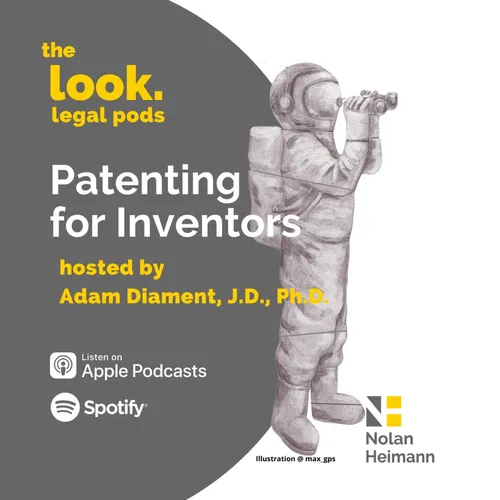
Patenting for Inventors
Learn the steps of how to patent your invention, from initial concept to issued patent. Host and registered patent attorney, Adam L. Diament, J.D., Ph.D., guides you through the complicated process of patenting your invention. This podcast starts from the beginning of what to do when you first have an idea, all the way through the steps that lead to an issued patent. Other intellectual property areas will also be covered, such as trademarks, copyrights, trade secrets, and licensing. Adam Diament is a partner at the law firm of Nolan Heimann LLP.
- Update frequency
- every 14 days
- Average duration
- 9 minutes
- Episodes
- 168
- Years Active
- 2017 - 2025

What are Provisional Patent Applications and Should I File One? EP008
In this episode I go over what provisional patent applications are, the differences between provisional and non-provisional patent applications, the pros and cons of provisional patent applications, …

What is the Patent Application Process? EP007
In this episode I go through what happens from when you file your patent application until your patent issues. There are lots of twists and turns your application can take so this is just a general …

How to Read and Understand the Parts of a Patent. EP006
In this episode I go through a brief introduction of the main six parts of a patent: 1) the abstract, 2) background of the invention, 3) summary of the invention, 4) brief description of drawings, 5)…

Should I Tell People About My Invention and What are the Patent Application Deadlines? EP005
In this episode I go through the problems of telling people about your invention, who you should get to sign non-disclosure agreements, and the deadlines to file your patent application if you've alr…

How to Patent Search and Find Similar Inventions? EP004
In this episode I go through ways to do a patent search, including key word searches, classification searches, and forward/backward citation searches. I also go through an example patent search for …

Is My Invention New, Useful and Non-Obvious? EP003
In this episode I go through the next steps to determine whether your invention might be patentable. In order to receive a patent, your invention must be new, useful, and non-obvious. But how is th…

Is My Idea Patentable? EP002
In this episode I tackle the question of whether your idea (or embodiments of your idea) is even eligible to receive a patent. I go through inventions and discoveries that can be subject to a patent,…

What is Intellectual Property and What Kind do I Need? EP001
In this episode I go through the four main types of intellectual property so you can determine whether you might need patent, trademark, copyright and/or trade secret protection.